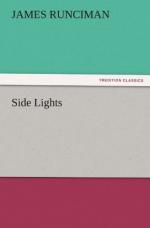His later literary work is well known to the world. He contributed to the St. James’s Gazette an admirable series of seafaring sketches, afterwards reprinted as “The Romance of the North Coast.” He also wrote “special” articles for the Standard and the Pall Mall, as well as essays on social and educational topics for the Contemporary and the Fortnightly. The humour and pathos of pupil-teaching were exquisitely brought out in his “School Board Idylls” and “Schools and Scholars”; his knowledge of the sea and his experience of fishermen supplied him with materials for “Skippers and Shellbacks” and for “Past and Present.” He was always a lover of his kind, so his work has almost invariably a strong sympathetic note; and perhaps his best-known book, “A Dream of the North Sea,” was written in support of the Mission to Fishermen. He produced but one novel, “Grace Balmaign’s Sweetheart”; but his latest work, “Joints in our Social Armour,” returned once more to that happier vein of picturesque description which sat most easily and naturally upon him.
The essays which compose the present volume were contributed to the columns of the Family Herald. And this is their history:—For many years I had answered the correspondence and written the social essays in that excellent little journal—a piece of work on which I am not ashamed to say that I always look back with affectionate pleasure. Several years since, however, I found myself compelled by health to winter abroad, and therefore unable to continue my weekly contributions. Who could fill up the gap? Who answer my dear old friends and questioners? The proprietor asked me to recommend a substitute. I bethought me instinctively at once of Runciman. The work was, indeed, not an easy one for which to find a competent workman. It needed a writer sufficiently well educated to answer a wide range of questions on the most varied topics, yet sufficiently acquainted with the habits, ideas, and social codes of the lower middle class and the labouring people to throw himself readily into their point of view on endless matters of life and conduct. Above all, it needed a man who could sympathise genuinely with the simplest of his fellows. The love troubles of housemaids, the perplexities as to etiquette, or as to practical life among shop-girls and footmen, must strike him, not as ludicrous, but as subjects for friendly advice and assistance. The fine-gentleman journalist would clearly have been useless for such a post as that. Runciman was just cut out for it. I suggested the work to him, and he took to it kindly. The editor was delighted with the way he buckled up to his new task, and thanked me warmly afterwards for recommending so admirable and so gentle a workman. Those who do not know the nature of the task may smile; but the man who answers the Family Herald correspondence, stands in the position of confidant and father-confessor to tens of thousands of troubled and anxious souls among his fellow-countrymen, and still more his fellow-countrywomen. It is, indeed, a sacerdoce. The essays are usually contributed by the same person who answers the correspondence; and the collection of Runciman’s papers reprinted in this little volume will show that they have often no mean literary value.




